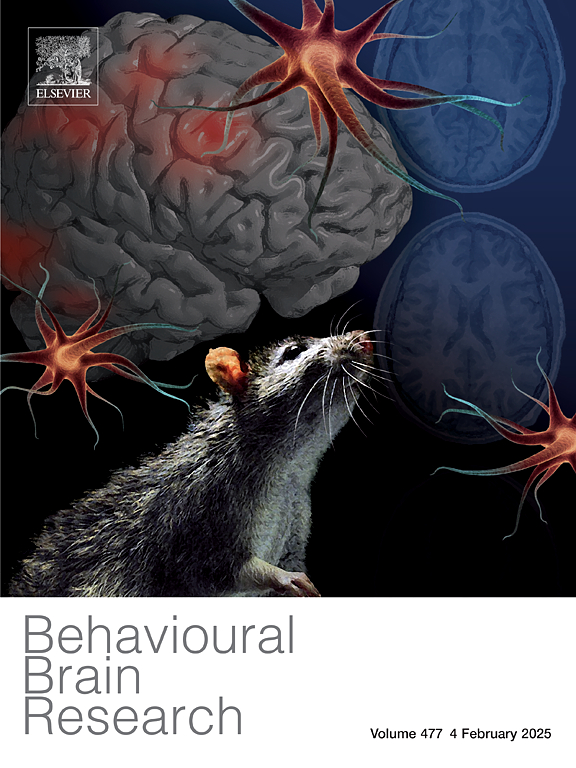设定标准:听觉MMN和P3a在双音节古怪任务中的习惯差异。
IF 2.3
3区 心理学
Q2 BEHAVIORAL SCIENCES
引用次数: 0
摘要
失配负性(MMN)和事件相关脑电图电位(ERP)的P3a可作为听觉刺激加工预测误差检测的指标。关于刺激作为标准或偏差的重要性的两个组成部分的特征现在已经被全面描述,但很少有人知道这些组成部分在建立标准或偏差时的行为。大多数调查使用的范式是计算每个参与者的许多刺激实例的平均值。因此,无法追踪将刺激建立为标准刺激的初始过程,即设定标准的最初过程。目前的研究使用了一个听觉古怪的任务,建立在先前使用双音音高范式的研究基础上,但结合了语音音节“ba”(标准)和“pa”(偏差)。少量刺激(11个偏差实例)应用于大量参与者样本(bbb230),以允许ERP表征为一系列标准和偏差刺激中标准或偏差位置的函数。我们发现,从标准/偏差对的第四次实例化开始,建立了(新)标准,并且无法检测到ERP对重复呈现标准刺激的进一步修改。对异常刺激的MMN和P3a成分分析发现,在异常刺激的第一次和第二次实例化之间,P3a有明显的习惯化,而MMN没有相关的习惯化,这表明MMN/P3a对重复的类言语听觉刺激的习惯化是不同的。本文章由计算机程序翻译,如有差异,请以英文原文为准。
Setting standards: Auditory MMN and P3a habituate differentially in a two-syllable oddball task
The Mismatch Negativity (MMN) and the P3a of the event-related EEG potential (ERP) serve as indices of prediction error detection in processing auditory stimuli. The characteristics of both components regarding the significance of the stimuli as standard or deviant have now been comprehensively described, but little is known about how these components behave during the establishment of standards or deviants. Most investigations used paradigms where the average of many instantiations of a stimulus per participant is calculated. Thus, the nascent process of establishing a stimulus as a standard stimulus, i.e., the very initial process of setting a standard, cannot be tracked. The present study used an auditory oddball task, building on a previous study using a two-tone pitch paradigm, but incorporating the speech syllables “ba” (standard) and “pa” (deviant). A rather small number of stimuli (11 deviant instantiations) was applied to a large sample of participants (> 230), to allow for ERP characterization as a function of the standard’s or deviant’s position in a series of standard and deviant stimuli. We found that, beginning with the fourth instantiation of the standard/deviant pair, the (new) standard was established, and no further modification of the ERP to repeated presentation of the standard stimulus could be detected. Analyzing MMN and P3a components to deviant stimuli revealed a prominent habituation of the P3a between the first and the second instantiation of the deviant, whereas no relevant habituation of the MMN could be detected, indicative of a differential MMN/P3a habituation to repeated speech-like auditory stimuli.
求助全文
通过发布文献求助,成功后即可免费获取论文全文。
去求助
来源期刊

Behavioural Brain Research
医学-行为科学
CiteScore
5.60
自引率
0.00%
发文量
383
审稿时长
61 days
期刊介绍:
Behavioural Brain Research is an international, interdisciplinary journal dedicated to the publication of articles in the field of behavioural neuroscience, broadly defined. Contributions from the entire range of disciplines that comprise the neurosciences, behavioural sciences or cognitive sciences are appropriate, as long as the goal is to delineate the neural mechanisms underlying behaviour. Thus, studies may range from neurophysiological, neuroanatomical, neurochemical or neuropharmacological analysis of brain-behaviour relations, including the use of molecular genetic or behavioural genetic approaches, to studies that involve the use of brain imaging techniques, to neuroethological studies. Reports of original research, of major methodological advances, or of novel conceptual approaches are all encouraged. The journal will also consider critical reviews on selected topics.
 求助内容:
求助内容: 应助结果提醒方式:
应助结果提醒方式:


